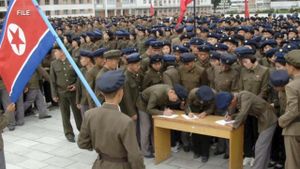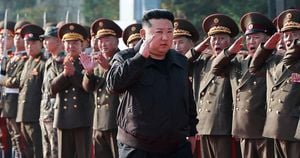China’s naval ambitions took center stage recently as the People’s Liberation Army Navy (PLAN) executed its inaugural dual aircraft carrier operations in the South China Sea. This significant military exercise, conducted with its two operational aircraft carriers, the CNS Liaoning and the CNS Shandong, marks an important milestone for the Chinese military and reflects its growing maritime capabilities.
The exercises unfolded late October but, intriguingly, the exact dates have not been disclosed by state media. Reports indicate the broader naval activities coincided with China’s public holidays, creating speculation about the timing of these maneuvers. What is evident, though, is the strategic message China aims to send to both regional adversaries and global powers.
Visuals released by the Chinese military revealed a stunning array of warships. Thirteen vessels participated alongside the two carriers, with aerial support from at least twelve carrier-based fighter jets. Among these fighter jets were the renowned Shenyang J-15A and J-15B, referred to as “flying sharks” by military insiders. The composite formation, sailing through the contested waters, showcased not just naval strength but also operational unity among China's naval forces.
This joint operation is seen as part of the PLAN’s annual training framework, intended to refine the operational capabilities of both carrier strike groups. The Defense Ministry of China emphasized this exercise’s purpose: to bolster team coordination and comprehensive combat readiness across the fleet. Analysts pointed out the importance of such operations for enhancing the systematic combat strength of China's navy.
Historically, China's naval fleet has undergone rapid evolution. Currently boasting more than 370 vessels, its ambition reflects a concerted effort to challenge the long-standing maritime supremacy of the United States, particularly across the Western Pacific region. Notably, the U.S. Navy maintains 11 aircraft carriers, all nuclear-powered. By comparison, China’s reliance on conventionally powered ships highlights both technological gaps and the breadth of its expansionary strategies.
The Liaoning has been operational since it was commissioned back in 2012, followed by the Shandong, China's first domestically built carrier, which was launched later. A third aircraft carrier, the CNS Fujian, unveiled just last year, is still undergoing rigorous sea trials. This trio is at the forefront of China’s naval development, and the presence of two active carriers reflects the navy’s ascending capabilities.
One cannot overlook the geopolitical dynamics intertwined with these military operations. The South China Sea is not merely a body of water; it’s the epicenter of various territorial disputes involving neighboring countries such as the Philippines, Vietnam, and Malaysia, who challenge China's expansive claims. The assertion of naval power by China through such dual carrier operations sends clear signals to those smaller nations and reasserts its contentious maritime strategy.
Citing imagery and operational movements, analysts noted how one of the carriers, the Liaoning, began its extensive naval drills as early as mid-September, transiting across multiple regions, including the East China Sea and the Philippine Sea. This showcases not only China’s naval reach but also its intention of establishing dominance over contested waters.
During the exercise, the Liaoning and Shandong formations navigated from the Yellow Sea, through to the East China Sea, and eventually to the South China Sea. Each phase of the operation was marked by rehearsals for various potential conflict scenarios, reiteratively demonstrating its readiness to engage if necessary.
Indeed, the timing of these drills coincided with heightened U.S. military activity. A U.S. aircraft carrier, the USS George Washington, was simultaneously conducting military exercises involving both U.S. and Japanese forces nearby. This inherent military posturing exemplifies the rising tensions and competitive maneuvering replacing traditional bilateral military engagements.
According to reports, as the Liaoning returned from its dual-carrier operations, it also circumscribed the territories of Taiwan and the Philippines—two areas of notable U.S. geopolitical interest and military collusion. The return passage through these strategic waters could deepen observers' concerns about China’s long-term military goals and the continued challenge it poses to U.S. influence.
The significance of the dual carrier drills extends beyond mere display; it embodies China's quest for increased operational flexibility and strategic deterrence against potential offensive claims made by rival nations. Each successful dual carrier exercise enhances the PLAN's operational flexibility, showcasing its ability to project power across vast stretches of water, even under supportive international scrutiny.
Besides military readiness and strategic deterrence, the dual operations also signal to the international community China’s commitment to demonstrating greater naval presence and operational confidence. This enhanced capability is expected to be accompanied by additional training exercises and potentially new maritime engagements with global partners who align with China's vision.
Looking forward, the capabilities exhibited during these exercises suggest China is preparing for diversified operations, which may encompass complex maritime scenarios. The need for operational proficiency will only increase, particularly as international naval dynamics evolve and competition grows among regional powers.
China's dual carrier operations, particularly their execution within the contentious South China Sea, will likely continue to provoke discussions and analyses concerning regional security dynamics, defense strategies, and military readiness. With the prospects of continued military growth and the introduction of advanced technologies, observers will be watching closely as China’s navy unfurls its sails toward dominance at sea.



